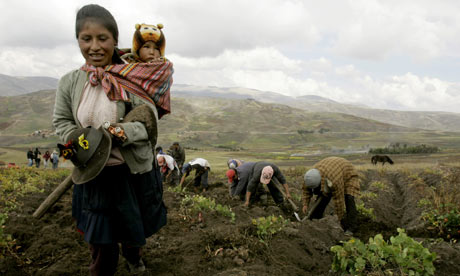In Peru, Quelccaya glacier, the largest in the tropics, could disappear within 10 years. Hello. The Peruvian Times reported just last month that studies of Quelccaya during the last 30 years have found the glacier retreated at an average rate of 6 meters per year during the first 15 years and 60 meters per year in the last 15. This year, it is expected to retreat 150 meters as a result of an unprecedented increase in global temperatures.
The Chacaltaya Glacier, thought to be 18,000 years old is now reduced to a rocky mountainside. Hello.
Water is a sensitive issue in Peru as desert covers its Pacific Ocean coast, where most of the population lives, and its Andean glaciers are melting because of climate change.
Just today the water issue led to a clash which left one dead and eighteen injured. According to Reuters, "The country's human rights office said the skirmish occurred before dawn in the town of Espinar, 400 miles (650 km) south of Lima. Police fought with protesters who say the Majes-Siguas II irrigation project will leave Espinar without water, said Silvio Campana of the rights office, which tries to mediate conflicts. The man who died was a bystander.
The following is from the Guardian.
"WE WILL HAVE NO WATER AND THAT WILL BE THE END OF THE WORLD FOR US"

Julio Hanneco is possibly the world's greatest potato grower. Some call him the King of Potatoes, but I prefer Señor Spud because Julio is as humble as the vegetable he grows.
He lives in a small village called Pampa Corral, at 4,020m (nearly 13,000ft) in the Cusco region, and he grows a staggering 215 varieties of potatoes - red ones, black ones, translucent ones, shapes and sizes you cannot imagine. He can name every one, like his family, but his favourite is a fantastically knobbly variety called Melchora, which he told me was designed to test out future daughters-in-law. "If they can peel in one piece this potato, then a prospective bride is considered worthy to marry the grower's son."
I met Julio in Lima, showing off his spuds to wide-eyed urban foodies who were amazed by this one-man seed bank and store of local knowledge. They all knew that Peru was the home of the potato 8,000 years ago, but few had any idea the country grew 3,000 of the world's 5,000 varieties.
And I doubt if any had read John Reader's marvellous book the Propitious Esculent, which charts human development through the cultivation of the potato. It was central to the 19th century global population explosion, it shaped the American revolution, it starred in the Conquistadores' invasion of Latin America and is now the world's fourth largest staple crop and one of the most nutritious of all foods.
But the point is, folk like Julio and their extraordinary diversity of crops are critically endangered by the massive changes they observe taking place in the High Andes. When Julio was a boy, (he's now in his 50s) a glacier was just two minutes walk from his door. Now it is a nine-hour hike away.
"The seasons used to be very clear, we knew when to plant. Now we have less water. We used to get the water from the glacier. Now we have twice as many mosquitoes. We have no light from the glacier I don't understand what is going on. We feel very disoriented," he said. "I think that I will have no water and that will be the end of the world for us."
Peru is said to be the 56th richest country in the world, with 28 of the world's 35 climates and more than 70% of the tropical glaciers on earth. Most are in rapid retreat, leaving behind devastated farmers and communities short of water.
Julio invited us to his home, but we are in the hands of Oxfam and heading for another region far from the retreating glaciers but where climate change is impacting communities hard.
No comments:
Post a Comment